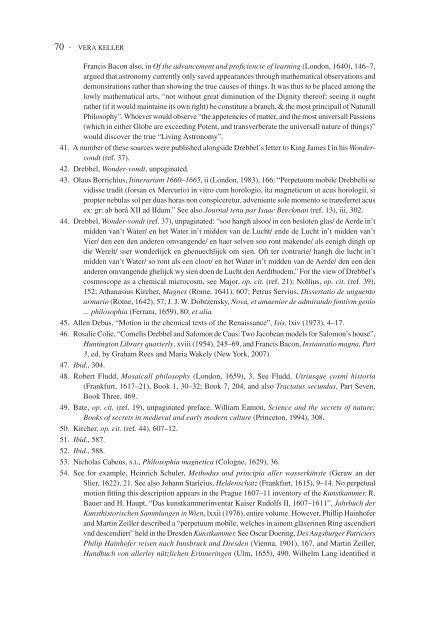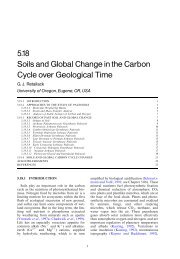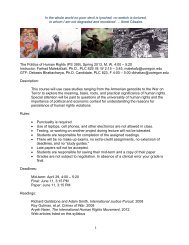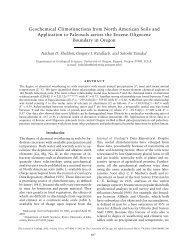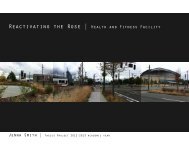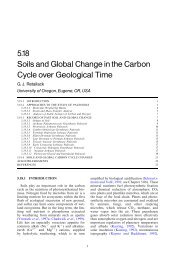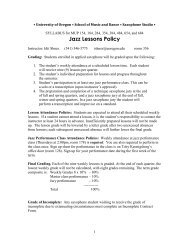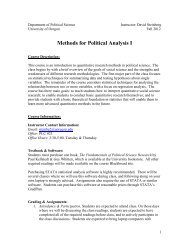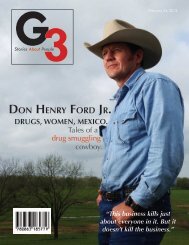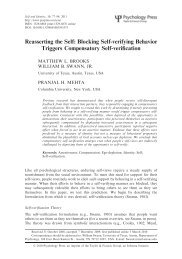drebbel's living instruments, hartmann's microcosm, and libavius's ...
drebbel's living instruments, hartmann's microcosm, and libavius's ...
drebbel's living instruments, hartmann's microcosm, and libavius's ...
Create successful ePaper yourself
Turn your PDF publications into a flip-book with our unique Google optimized e-Paper software.
70 · VERA KELLERFrancis Bacon also, in Of the advancement <strong>and</strong> proficiencie of learning (London, 1640), 146–7,argued that astronomy currently only saved appearances through mathematical observations <strong>and</strong>demonstrations rather than showing the true causes of things. It was thus to be placed among thelowly mathematical arts, “not without great diminution of the Dignity thereof; seeing it oughtrather (if it would maintaine its own right) be constitute a branch, & the most principall of NaturallPhilosophy”. Whoever would observe “the appetencies of matter, <strong>and</strong> the most universall Passions(which in either Globe are exceeding Potent, <strong>and</strong> transverberate the universall nature of things)”would discover the true “Living Astronomy”.41. A number of these sources were published alongside Drebbel’s letter to King James I in his Wondervondt(ref. 37).42. Drebbel, Wonder-vondt, unpaginated.43. Olaus Borrichius, Itinerarium 1660–1665, ii (London, 1983), 166: “Perpetuum mobile Drebbelii sevidisse tradit (forsan ex Mercurio) in vitro cum horologio, ita magneticum ut acus horologii, sipropter nebulas sol per duas horas non conspiceretur, adveniente sole momento se transferret acusex: gr: ab horâ XII ad IIdam.” See also Journal tenu par Isaac Beeckman (ref. 13), iii, 302.44. Drebbel, Wonder-vondt (ref. 37), unpaginated: “soo hangh alsoo/ in een besloten glas/ de Aerde in’tmidden van’t Water/ en het Water in’t midden van de Lucht/ ende de Lucht in’t midden van’tVier/ den een den <strong>and</strong>eren omvangende/ en haer selven soo ront makende/ als eenigh dingh opdie Werelt/ sser wonderlijck en ghenuechlijck om sien. Oft ter contrarie/ hangh die lucht in’tmidden van’t Water/ so ront als een cloot/ en het Water in’t midden van de Aerde/ den een den<strong>and</strong>eren omvangende ghelijck wy sien doen de Lucht den Aerdtbodem.” For the view of Drebbel’scosmoscope as a chemical <strong>microcosm</strong>, see Major, op. cit. (ref. 21); Nollius, op. cit. (ref. 39),152; Athanasius Kircher, Magnes (Rome, 1641), 607; Petrus Servius, Dissertatio de unguentoarmario (Rome, 1642), 57; J. J. W. Dobrzensky, Nova, et amaenior de admir<strong>and</strong>o fontivm genio... philosophia (Ferrara, 1659), 80; et alia.45. Allen Debus, “Motion in the chemical texts of the Renaissance”, Isis, lxiv (1973), 4–17.46. Rosalie Colie, “Cornelis Drebbel <strong>and</strong> Salomon de Caus: Two Jacobean models for Salomon’s house”,Huntington Library quarterly, xviii (1954), 245–69, <strong>and</strong> Francis Bacon, Instauratio magna, Part3, ed. by Graham Rees <strong>and</strong> Maria Wakely (New York, 2007).47. Ibid., 304.48. Robert Fludd, Mosaicall philosophy (London, 1659), 3. See Fludd, Utriusque cosmi historia(Frankfurt, 1617–21), Book 1, 30–32; Book 7, 204, <strong>and</strong> also Tractatus secundus, Part Seven,Book Three, 469.49. Bate, op. cit. (ref. 19), unpaginated preface. William Eamon, Science <strong>and</strong> the secrets of nature:Books of secrets in medieval <strong>and</strong> early modern culture (Princeton, 1994), 308.50. Kircher, op. cit. (ref. 44), 607–12.51. Ibid., 587.52. Ibid., 588.53. Nicholas Cabeus, S.J., Philosophia magnetica (Cologne, 1629), 36.54. See for example, Heinrich Schuler, Methodus und principia aller wasserkünste (Geraw an derSlier, 1622), 21. See also Johann Staricius, Heldenschatz (Frankfurt, 1615), 9–14. No perpetualmotion fitting this description appears in the Prague 1607–11 inventory of the Kunstkammer. R.Bauer <strong>and</strong> H. Haupt, “Das kunstkammerinventar Kaiser Rudolfs II, 1607–1611”, Jahrbuch derKunsthistorischen Sammlungen in Wien, lxxii (1976), entire volume. However, Phillip Hainhofer<strong>and</strong> Martin Zeiller described a “perpetuum mobile, welches in ainem gläserinen Ring ascendiertvnd descendiert” held in the Dresden Kunstkammer. See Oscar Doering, Des Augsburger PatriciersPhilip Hainhofer reisen nach Innsbruck und Dresden (Vienna, 1901), 167, <strong>and</strong> Martin Zeiller,H<strong>and</strong>buch von allerley nützlichen Erinneringen (Ulm, 1655), 490. Wilhelm Lang identified it


